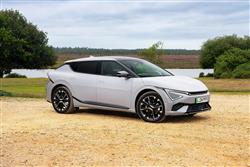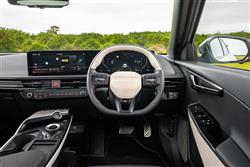Kia EV6 - ABC Leasing
How will you view?
This is a sample, showing 30 seconds of each section.
SIX PACK(some text hidden)
By Jonathan Crouch
Ten Second Review word count: 53
Kia's EV6 has long been difficult to ignore in the affordable part of the mid-sized EV segment, but competition has stiffened in recent times, hence the need for this smarter, classier-feeling longer-ranging facelifted model. Can it keep this bold Korean maker on the podium in this challenging segment? We're going to find out.
Background word count: 177
Prior to the 2021 arrival of this EV6, Korean maker Kia's offerings had been worthy, sensible, good value and, whisper it, rather dull. But that changed with this car's introduction. The idea here was to reinterpret full-electric technology for the affordable part of the mid-sized market in a sporty, desirable fashion. And create a really appealing Korean alternative to established style-conscious segment choices like the Polestar 2 or Tesla Model 3. That was quite a challenging brief for a manufacturer just evolving from budget brand status, but Kia went about it with enthusiasm. A great advantage lay with its access to the Hyundai Motor Group's advanced 800V E-GMP platform, which the EV6 would share with its similarly engineered close cousins the Hyundai IONIQ 5 and the Genesis GV60. And the design team built on this sure foundation with distinctive looks and surprisingly accomplished handling. By 2024 though, other rivals were fronting up with smarter-looking cabins and better EV mileages, hence the need for an EV6 facelift package that addressed both these things with a smart exterior refresh.
Driving Experience word count: 444
Very little has changed about the way this improved EV6 drives, though not too much needed to. Perhaps the biggest difference with this facelifted car is one Kia doesn't want to talk about, a largely unexplained 80kg weight increase. No part of which is down to the biggest engineering change here, a new slightly larger-capacity 84kWh battery, which is fractionally lighter than the old 77.4kWh unit but, more importantly, boosts driving range by a very useful amount - from 328 to 361 miles in the base 225bhp rear-driven version. This makes 62mph in 7.7s (nearly half a second slower than before thanks to that extra weight). If you don't need quite as much EV range as that, there's also the option of a smaller 63.0kWh battery offering 265 miles of range. Most will want the larger battery and with that, as before, there's also the option of having your EV6 with an electric motor on both axles, rather than just one at the rear, creating the AWD model we tried. With this, the extra little 74kW motor at the front boosts total output to 320bhp, which provides for 62mph in 5.3s and nearly twice the amount of pulling power - 605Nm - on the way to the 114mph top speed that all versions of this Kia share. Range with an AWD EV6 is up to 339 miles - up from 314 miles before. There's a top GT model with up to 641bhp and up to 279 miles of range. This isn't one of those EVs that hurls itself away from rest or catapults itself at the horizon, which for us is a good thing, the delivery of torque and speed here being pleasantly linear and combustion-like. If you want an EV6 that does kick you in the back away from rest, Kia will attempt to sell you a top GT model with a twin motor output uprated to 641bhp if you select GT mode. But you don't really need that GT model's manic speed - rest to 62mph in just 3.5s en route to 162mph; and you don't really need its standard adaptive damping system either because the passive 'frequency selective' mechanical springs that feature on standard EV6s (which can't be upgraded) combine with the multi-link independent rear suspension to produce an actually very well judged quality of ride over poor surfaces. There are three drive modes ('Eco', 'Normal' and 'Sport'), none of which improve the rather gloopy feel of the steering. But the six available brake regeneration settings (most operable by the steering wheel paddle shifters) are effective and careful use will get you somewhere near the quoted combined cycle drive range figures.
Pictures (High res disabled)

.jpg)
.jpg)
.jpg)
.jpg)
.jpg)
.jpg)
.jpg)
.jpg)
.jpg)

Scoring
Category: Compact Car
| Performance | |
| Handling | |
| Comfort | |
| Space | |
| Styling | |
| Build | |
| Value | |
| Equipment | |
| Economy | 70% |
| Depreciation | 50% |
| Insurance | 60% |
| Total | 67% |